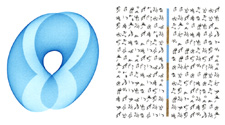Algorithmic art, Roman Verostko
In a bizarre coincidences, I spent a few minutes on Monday googling around generative art and came across Roman Verostko - then on Tuesday morning I received an email alerting me to a lecture he was giving at Lighthouse, a couple of streets away from our offices.
Roman talked about his life, growing up in the Depression and spending 18 years as a monk, his influences (Kandinsky, who saw "visual form analogous to musical form", in that it didn't need to be representation of something other, and Gabo, particularly his Standing Wave piece currently at Tate) and his work.
Psalms in sound and image was one of his first "multimedia" pieces, using two slide projectors and a tape recorder - it was all very "sixties". Verostko then wanted to move from guiding a hand to produce art, to guiding a machine. This led to Magic Hand of Chance which combined algorithmic drawings with generated text, all created using parameterised controls, "high school maths" and extremely carefully selected dictionaries of nouns, adjectives, etc. The output of the text is very Zen-sounding nonsense, a "computer-generated mime of language".
Verostko seems to see machine-driven creativity, where a family of forms can be generated from the same code, as not dissimilar from the way "real" artistry works: the same materials and artist can lead to many different expressions. "All you need is the seed to clone a piece". He writes his own code and uses nothing commercial - expressing a vague embarrassment at one point that he'd used Photoshop for some typesetting and image manipulation in producing a book. He referred to Stonehenge as being a "generative structure", with the inputs being position of the sun, the stones, etc., and maintains that algorithmics is deeply embedded into all art, across all cultures. Analogies were also drawn between code and biology - which is hardly new, but might have been a bit less hackneyed when he first came up with it ;) And as he said beautifully plainly, "every analogy limps".
One view which I noticed he didn't share with the audience was the relationship between screen and printed output. A couple of questions leaned towards asking about his use of a pen plotter - why use such an archaic technology nowadays? His reply was that he was interested in the plotter as an extension of the human arm, and that the patterns which are thrown up by continuous overwriting of lines are both interesting in themselves, and impossible to replicate using inkjet or similar technology. It was interesting to see the (younger) audience assume that the role of a printer is to replicate the contents of a screen, whilst the artist didn't have much use for the screen as a canvas: his plotter-driven work had no "preview mode", the works had to be generated in full and then examined. We were assured this meant lots of BASIC, plain geometry, a disciplined approach, and plenty of bug fixing...
 By far my favourite work was the Pearl Park Scriptures, a set of algorithmic drawings (which I think he called "cyberflowers") which combine plotted geometric patterns with either quotations or meaningless text rendered alongside in an alternative alphabet of glyphs.
By far my favourite work was the Pearl Park Scriptures, a set of algorithmic drawings (which I think he called "cyberflowers") which combine plotted geometric patterns with either quotations or meaningless text rendered alongside in an alternative alphabet of glyphs.
A fantastic talk from an extremely interesting speaker, and a crowd of folks (art students I suspect) who I'd not come across in my Brighton/digital wanderings. I'll be keeping an eye out for what Lighthouse run next...